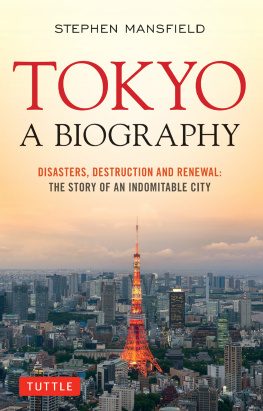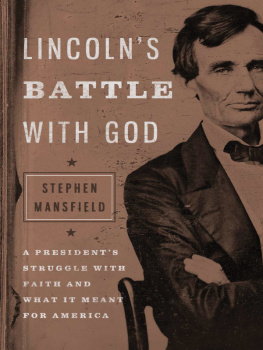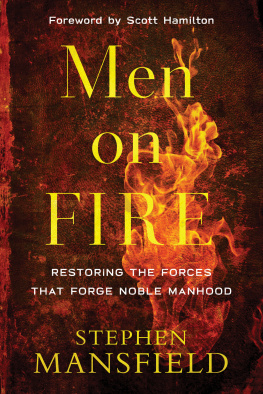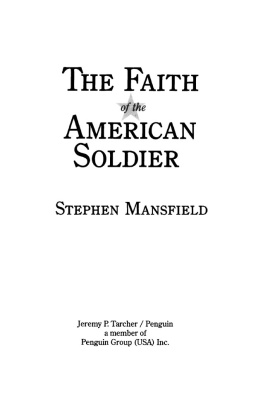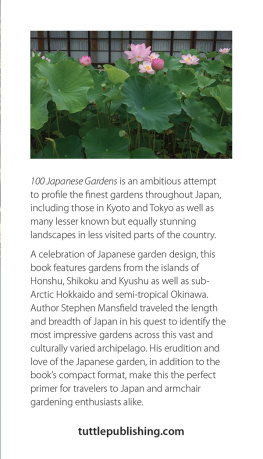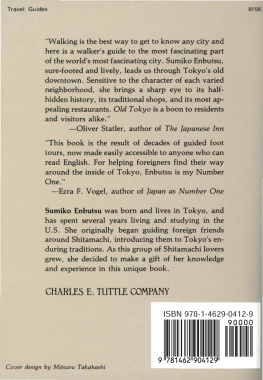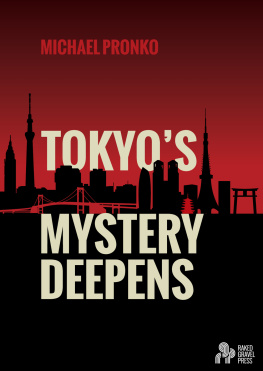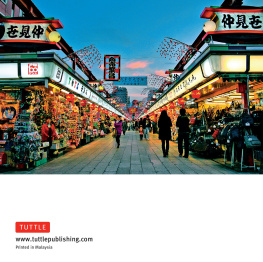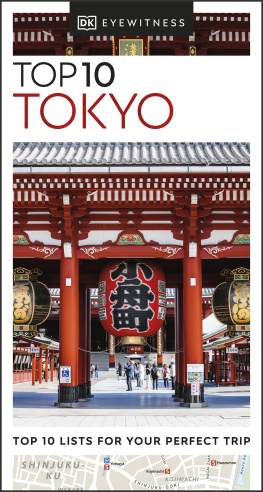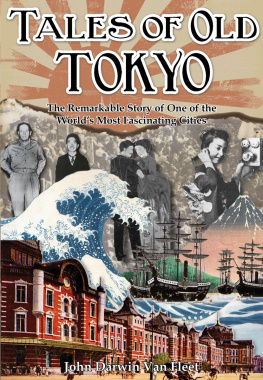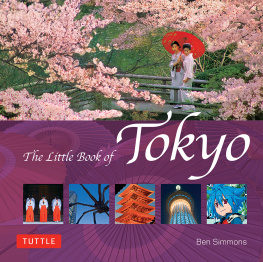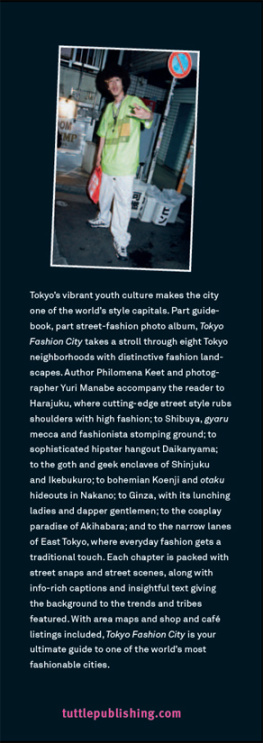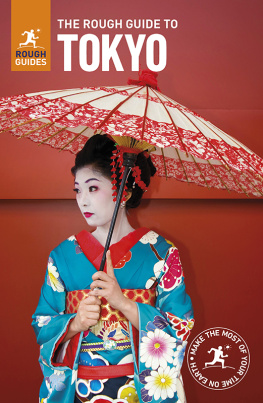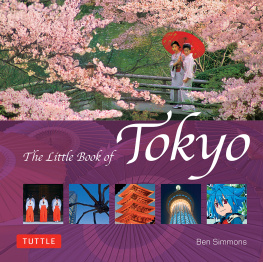AFTERWORD
Plural Zones
Those who try to predict the future of modern metropolises are apt to end up as superannuated Cassandras. The study of past occurrences and portents as a means to understanding the nature of future eventsand perhaps of managing themcan be traced to the use of oracle bones for divination in ancient China, the omen tablets of Babylon, and the dialectical materialism practiced by Marx, Engels, and Lenin.
The inaccuracy of such methods may be manifest, the imprecision of engaging in speculative mapping of the future obvious, but even in such an unreadable city as Tokyo, there are trend lines. The fact that a thousand years ago, three of the worlds largest citiesPalermo, Seville, and Cordobawere Muslim counts for little today. Facts do not always carry relevance in the long view of history, but it is significant that Tokyo is now the worlds largest metropolis. Other cities midwifed by great cultures may have receded, crumbled into the sand like Leptis Magna, or become architectural artifacts, but Tokyos stock has risen, invigorated by each of its transformations. There is no reason to suggest an end to the hybrid urbanism that makes the city such an electrifying place to be.
Tokyo has done little to halt the obliteration of history. In a way it is the perfect contemporary city, one that has triumphed over the past by putting history at the rear end of time, and then getting on with the present. A tendency to eviscerate or conceal the material past in favor of an infinite number of alternative futures is no longer confined to Japanese cities. Only a few decades ago, the tallest buildings in London were its church spires. That notion of the skyline as celestial died with the construction of the blandly designed Millbank Tower and the even more conspicuous 1965 Post Office Tower, a structure whose height surpassed Saint Pauls Cathedral. Today many of Londons architectural monuments are overshadowed by commercial and residential blocks. In the ancient city of Mecca, where you might suppose Saudi orthodoxy would cherish the past, the residence of Khadijah, the Prophet Muhammads first wife, has been converted into a block of toilets; the home of Abu Bakr, a close friend of the prophet and Islams first caliph, was bulldozed to make way for the construction of the Makkah Hilton Hotel.
Change is not confined to the surface. An entire sub-basement city is emerging as Tokyo digs deeper into the earth in search of new ways to achieve decongestion. The inner-city substrata associated with subway lines, sewage channels, and underground streams is being augmented with gleaming malls, restaurants, and cafs. With a byzantine network of shopping tunnels already in place beneath Tokyo Station and more excavations planned, a large proportion of residents from now on will be negotiating an entire sub-basement city.
Tokyos underground development began in 1927, with the opening of the Ginza Line subway connecting Asakusa with Ueno Station. By 1930, the first underground shops appeared in Ueno Station. The subway system has almost reached capacity, with concern periodically raised about the wisdom of undermining the citys already unstable foundations. In many ways, the system is laudable. It maximizes available space; unlike the New York or Paris undergrounds, every crevice is lit up with bright lights, with no disused corners or areas of darkness visible from the platforms. Tokyo is the exception, though, among large international cities, for not having an all-night transportation system. The Tokyo Metro and metropolitan governmentmanaged stations extend to more than 280 sites and carry more than eight million passengers a day. The lines undulate above and below each other, carefully avoiding other infrastructure such as sewage, electric, and gas pipes; underground parking lots; and communication cables. At the larger subway complexes, lines are separated by just a hands breadth: in Shinjuku-Sanchome Station, the Fukutoshin Line is a mere 11 centimeters above the Toei Shinjuku Line that runs on the lower level.
In European cities like Barcelona and Frankfurt, freeways were long ago banished to the perimeters; in Tokyo, they penetrate the very center of the metropolis. In an effort to relieve congestion and promote traffic circulation, more expressway offshoots have been grafted onto the existing system in an operation resembling a multiple heart bypass. A plan is gaining traction to rid the city of aging elevated sections of its Metropolitan Expressway by constructing a highway network some 40 meters underground. The existing highway, almost a third of which is more than fifty years old and not quakeproof, was constructed in great haste to meet the 1964 Olympic deadline. By 1967, the elevated sections of the system ran to 32.5 kilometers; today the Metropolitan Expressway stretches more than 300 kilometers. The new scheme would include a long-cherished plan to place a 2-kilometer section of expressway that currently runs directly above the landmark Nihonbashi bridge below ground.
The dangers of such a confined, perpetually congested system would be compounded by unacceptably high levels of nitrogen-oxide emissions. The theory that the magnitude of an earthquake diminishes with depth is a convincing argument for a subterranean road system, but the follies of hasty, ill-conceived construction are evident inside the Sendagaya Tunnel, a section of road laid in 1964. For drivers who claim to have witnessed the occasional sighting of a long-haired female ghost hanging upside-down from the ceiling, the poltergeists propensity to drop down on cars with a sickly thud highlights the imprudence of building such a tunnel beneath a cemetery. In 2014, underground congestion forced developers to divert a section of a 900-meter tunnel in Minato ward through the basement floor of a fifty-two-story skyscraper in the commercial and residential compound of Toranomon Hills. With the Tokyo metro turning into a hollowed-out complex of malls and tunnels brushing against the footings of ever-taller skyscrapers, few planners appear to be considering the probability of subsidence, or even sinkholes.
A dome of heat hangs over the pressurized city in the summer months, pressing exhaust fumes into its living and working quarters. The national population density will continue to decline while that of Tokyo grows, highlighting the disproportionalities that have long characterized the city. Temperatures will continue to rise, not simply because of the massive amounts of energy needed to illuminate the city, but from sheer body heat. At its densest, Tokyo can resemble Kolkata, albeit far more self-disciplined and efficiently run.
The density of the city and its inconceivable number of residents make it possible to spend your entire life in Tokyo without ever glimpsing the ocean. You may not even sense the sea, living behind the phalanx of towers that line the bay area and impede the relieving breezes that might circulate through the city. Satellite images of Tokyo show a land mass leached of color. Whereas 30 percent of London is set aside for parks and gardens, Tokyo devotes a meager 5 percent. Thermograph maps of central Tokyo illustrate the benefits of greenery, with residential blocks near large gardens and parks registering cooler temperatures than the superheated congestion of districts and neighborhoods where most people live and work.
Typically, such unchecked development leads to grave social and structural concerns. Miraculously, Tokyo has managed to avoid many of the ill effects of intense urbanization, and can boast an efficient public transportation system, friendly neighborhoods, and a relatively low crime rate. It is a safe city to walk in, even at night. What is remarkable about contemporary Tokyo is that, despite its bewildering complexity, the city manages to function as a single, stable organism. The notion, however, of what Edward Seidensticker called a single, concentrated orthodoxy no longer exists. That is not to say that Tokyo is anywhere near becoming an embryonic version of Berlin or Dubai. Tokyo is a cosmopolitan city, but few of its inhabitants are cosmopolitan. The prospect of a more heterogeneous Tokyo is not universally welcomed. There are many who equate it with poisoning the well. Racial tensions are inevitable, but the kind of riots associated with the council estates of London or the banlieues of Paris are improbable.

